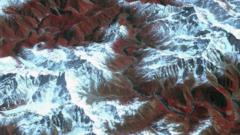China has officially launched the construction of what is poised to become the world's largest hydropower dam in the Yarlung Tsangpo canyon, an area recognized as the deepest canyon on the planet. The ceremony was presided over by Chinese Premier Li Qiang on Saturday, according to local reports. This ambitious project, taking place in Tibet, has ignited apprehensions in India and Bangladesh regarding its potential repercussions.
The Yarlung Tsangpo River, flowing through the Tibetan plateau, is at the center of this $167 billion initiative. Environmentalists and local authorities worry about the downstream impact on millions of people living in India and Bangladesh. Beijing, however, asserts that the project will enhance ecological welfare and stimulate local economic growth.
When finished, the dam, officially referred to as the Motuo Hydropower Station, is expected to supersede the Three Gorges Dam in capacity, aimed at generating three times the energy output. There are growing fears that this dam will give China leverage to manipulate water flow in the transnational river, affecting regions in Arunachal Pradesh and Assam in India, alongside areas in Bangladesh where the river feeds into the Siang, Brahmaputra, and Jamuna rivers.
Arunachal Pradesh Chief Minister Pema Khandu has publicly expressed alarm that the construction could lead to significant water scarcity in the Siang and Brahmaputra rivers. He warned that the dam could pose an "existential threat" to local tribes and livelihoods. He described a potential scenario where a sudden water release from the dam could devastate the Adi tribe and the surrounding communities.
In response to these dangers, India has voiced concerns about the impact of major dams to the Chinese government, urging them to consider the interests of downstream nations and advocating for transparency in communications. Meanwhile, India is planning to counter the potential threat by constructing its own hydropower dam on the Siang River.
The anticipated dam has also drawn the attention of Bangladesh, with officials reaching out to China for further transparency surrounding the project. The Yarlung Tsangpo's dam site, which utilises a formidable canyon drop, promises immense hydropower potential. Tunneling plans through the Namcha Barwa mountain are already in motion, where engineers will create infrastructure capable of diverting river water for energy generation.
China is keenly pursuing projects to harness hydropower in its western regions, aiming to distribute the generated electricity to its industrial eastern cities. While the government presents these initiatives as beneficial for environmental sustainability and Tibetan development, activists claim they further entrench the exploitation of Tibetan land and deny local communities their rights.
Protests against such dams have previously resulted in serious repercussions, including arrests and violence against demonstrators. Environmental issues pose additional risks, particularly in areas susceptible to seismic activity, raising questions about the long-term safety of such infrastructure in Tibet's delicate ecological landscape.
The Yarlung Tsangpo River, flowing through the Tibetan plateau, is at the center of this $167 billion initiative. Environmentalists and local authorities worry about the downstream impact on millions of people living in India and Bangladesh. Beijing, however, asserts that the project will enhance ecological welfare and stimulate local economic growth.
When finished, the dam, officially referred to as the Motuo Hydropower Station, is expected to supersede the Three Gorges Dam in capacity, aimed at generating three times the energy output. There are growing fears that this dam will give China leverage to manipulate water flow in the transnational river, affecting regions in Arunachal Pradesh and Assam in India, alongside areas in Bangladesh where the river feeds into the Siang, Brahmaputra, and Jamuna rivers.
Arunachal Pradesh Chief Minister Pema Khandu has publicly expressed alarm that the construction could lead to significant water scarcity in the Siang and Brahmaputra rivers. He warned that the dam could pose an "existential threat" to local tribes and livelihoods. He described a potential scenario where a sudden water release from the dam could devastate the Adi tribe and the surrounding communities.
In response to these dangers, India has voiced concerns about the impact of major dams to the Chinese government, urging them to consider the interests of downstream nations and advocating for transparency in communications. Meanwhile, India is planning to counter the potential threat by constructing its own hydropower dam on the Siang River.
The anticipated dam has also drawn the attention of Bangladesh, with officials reaching out to China for further transparency surrounding the project. The Yarlung Tsangpo's dam site, which utilises a formidable canyon drop, promises immense hydropower potential. Tunneling plans through the Namcha Barwa mountain are already in motion, where engineers will create infrastructure capable of diverting river water for energy generation.
China is keenly pursuing projects to harness hydropower in its western regions, aiming to distribute the generated electricity to its industrial eastern cities. While the government presents these initiatives as beneficial for environmental sustainability and Tibetan development, activists claim they further entrench the exploitation of Tibetan land and deny local communities their rights.
Protests against such dams have previously resulted in serious repercussions, including arrests and violence against demonstrators. Environmental issues pose additional risks, particularly in areas susceptible to seismic activity, raising questions about the long-term safety of such infrastructure in Tibet's delicate ecological landscape.




















